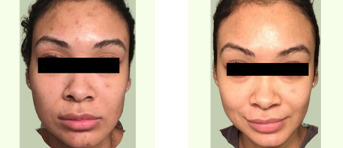
COVID-19 NOTICE : Safety measures implemented

31
May
Washington, D.C. dermatologist explains what you need to know about acne during pregnancy

Pregnancy can be a beautiful, life-changing experience, but it also takes a toll on the body both physically and emotionally. One major occurrence for many women is changes to the skin, most commonly, acne. While some women are gifted with the much talked about “pregnancy glow” others are dealing with breakouts that make them feel like a “pimply-faced” teenager again.
Fortunately, acne during pregnancy is a common occurrence and there are things you can do about it. Washington, D.C. dermatologists at the Center for Dermatology and Dermatologic Surgery discuss what you need to know about acne during pregnancy.
Why does acne occur more frequently during pregnancy?
The easiest answer is hormones. During the first trimester androgen production increases to support the development of the baby. As the androgens are converted into estrogen and progesterone, it increases oil (sebum production). This excess oil leads to clogged pores and bacteria build up, resulting in acne breakouts.
Are certain people more at risk for acne during pregnancy?
If you struggled with acne during adolescence, you’ll probably end up dealing with it during pregnancy. Additionally, if you had acne breakouts during previous pregnancies, it is likely that it will occur again in subsequent pregnancies.
What can I do to treat acne during pregnancy?
Whenever you are pregnant, it’s important to pay attention to the products you use, as anything you put on your skin or into your body can have an impact on the health of your baby. There are some acne treatments that pose a high risk of birth defects, so always consult with your OB/GYN and your dermatologist before you begin any sort of acne treatment while pregnant.

The following products are safe for treating acne while pregnant:
Glycolic Acid
Glycolic acid is derived from sugar cane. It’s an AHA (alpha hydroxy acid) and is known for its excellent peeling and exfoliating characteristics. Glycolic acid is often used in the treatment of acne, psoriasis, enlarged pores and keratosis pilaris.
In addition to removing the dead skin cells, glycolic acid stimulates collagen and elastin production, which improves skin healing and the texture of the skin.
Lactic Acid
Lactic acid is derived from milk, fruit and vegetables or it can be made synthetically. It has a gentle exfoliation power and stimulates cellular turnover. Lactic acid is a little gentler than glycolic acid and can help improve the appearance of acne breakouts.
Azelaic Acid
Azelaic acid occurs naturally in grains such as wheat, barley and rye. It works by penetrating deep into the pores to clean out buildup up of dead skin cells and bacteria. It can also help reduce excess oil production. Azelaic acid has anti-inflammatory effects, so it can dull redness and help even out skin tone.
Other treatment options
If you have tried those three ingredients in various products without success, your doctor can look at prescribing various medications including topical or oral antibiotics for recalcitrant cystic acne. Light based treatment such as phototherapy is also a safe option to improve the appearance of acne. For severe cases, your doctor may recommend corticosteroids to prevent scarring.
What ingredients should I avoid in acne treatments while pregnant?
The following products should not be used while pregnant due to the risks they pose to the health of your baby:
Retinoid – the anti-aging ingredient can produce great results on the skin, but it has been shown to cause birth defects and should be avoided during pregnancy.
Salicylic Acid – the beta hydroxy acid is commonly found in acne skin care products and is effective at controlling oil production and clearing skin, but it can cause potential complications or birth defects and should also be avoided during pregnancy.
Call Center for Dermatology and Dermatologic Surgery for your acne treatment during pregnancy
In addition to the physical toll it takes, acne can also have a significant impact on mental health. Individuals with acne breakouts may feel embarrassed to step out in professional or social situations, which can lead to isolation, anxiety and depression.
If you are suffering from acne during your pregnancy, we can work with you to design a treatment plan that is effective and safe for you and your baby. If you are in the Washington, D.C. area, call us today at (410) 224 1195 to set up an appointment.
